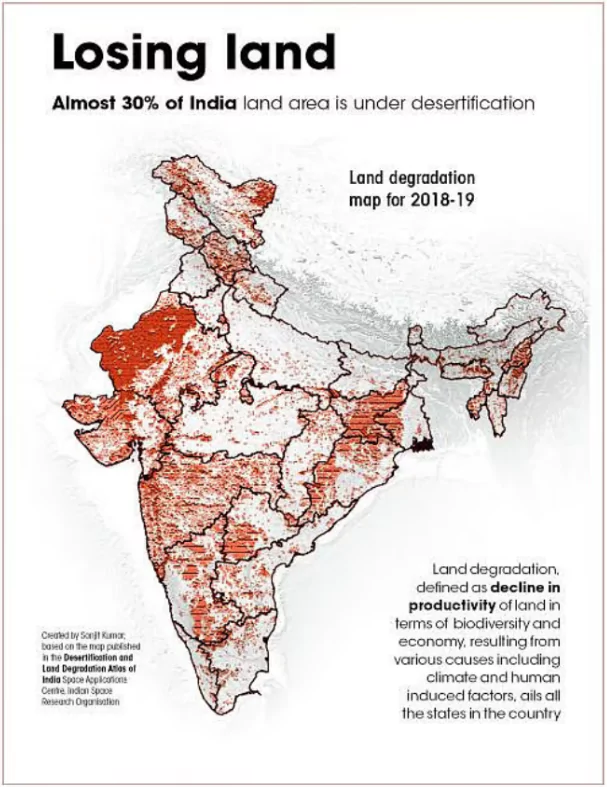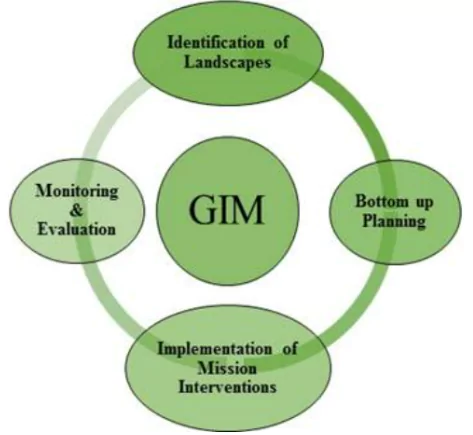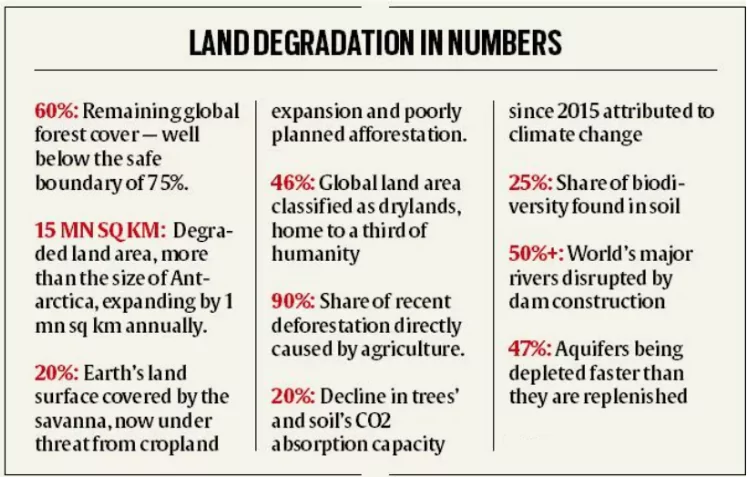Recently, the MoEFCC held a national workshop at ICFRE-AFRI, Jodhpur, themed “Strategies for Combating Desertification and Drought,” coinciding with World Day to Combat Desertification and Drought.
- The Ministry of Environment, Forest and Climate Change (MoEFCC) has also released the revised Green India Mission on World Day to Combat Desertification and Drought.
About Green India Mission (GIM)

- The Green India Mission (GIM), also known as National Mission for a Green India, is a key part of India’s National Action Plan on Climate Change (NAPCC).
- The mission aims to protect, restore, and enhance India’s forest cover while tackling climate change.
- GIM focuses on improving biodiversity, water resources, and ecosystems like mangroves and wetlands, all while helping absorb carbon.
- Mission Goals:
- Expand forest/tree cover by 5 million hectares (mha) and improve the quality of another 5 mha of forest and non-forest land.
- Boost ecosystem services like carbon storage, water management, and biodiversity.
- Improve livelihoods for 3 million households by increasing income from forest-based activities.
- Sub-Missions: GIM has five sub-missions, each focused on a different aspect of greening:
- Enhancing Forest Cover – Improving Forest quality and ecosystem services.
- Ecosystem Restoration – Reforesting and increasing forest cover.
 Urban Greening – Adding more trees in cities and nearby areas.
Urban Greening – Adding more trees in cities and nearby areas.- Agro-Forestry & Social Forestry – Boosting biomass and creating carbon sinks.
- Wetland Restoration – Reviving critical wetlands.
- Funding and Expenditure:
- As of July 2024, Rs. 909.82 crores have been allocated to 17 states and one Union Territory for plantation and eco-restoration over 155,130 hectares.
- The financial outlay under the Mission is ₹12,190 crore for implementation of afforestation activities over 1.0 million hectares during the period of 10 years (2021-30).
Revised GIM
- A ‘micro-ecosystem’ approach will be adopted to make interventions in the vulnerable landscapes like Aravallis, Western Ghats, arid regions of North West India, mangroves and the Indian Himalayan region.
- Targets:
- It also projected, based on estimates of the Forest Survey of India (FSI), that India could achieve a carbon sink of 3.39 billion tonnes, from the combination of all restoration activities.
- This will require an increase in forest and tree cover over an estimated 24.7 million hectares.
- Annual afforestation/ tree plantation at the current trend of over 2 million hectares should cover another 12 million hectares during 2025-30.
Key Focus Areas of Updated Mission
- Aravalli Hills Restoration: 700 km stretch from Gujarat to Delhi; one of the world’s oldest mountain ranges.
- Western Ghats Restoration: 1,600 km from Gujarat to Tamil Nadu; one of 34 global biodiversity hotspots.
- Himalayan Slopes Restoration: Prevent soil erosion, control landslides, improve rainwater harvesting.
- Methods: Planting native species.
- Techniques like gully plugging and contour trenching to stabilize slopes.
- Northeast Interventions: Address jhum (shifting) cultivation with locally appropriate, respectful technologies.
- Seabuckthorn Plantations: Promote in Himachal Pradesh, Jammu & Kashmir, Uttarakhand, and Sikkim to enhance ecology and livelihoods.
- Arid Northwest India: Soil erosion due to wind, overgrazing, poor land management, vegetation loss.
- Strategies:
- Plant windbreaks.
- Regulate grazing, conserve soil and water.
- Introduce hardy native grasses, promote rainwater harvesting.
About World Day to Combat Desertification and Drought
- Observed annually on June 17.
- Established: 1994 by the UN General Assembly to mark the adoption of the United Nations Convention to Combat Desertification (UNCCD).
- Purpose: Promote public awareness about desertification, land degradation, and drought, and encourage actions for sustainable land management.
- 2025 Theme: “Restore the Land. Unlock the Opportunities”.
|
About Desertification and Land Degradation

- Land degradation is the process where the biological or economic productivity and complexity of land resources (including soil, vegetation, and water) are reduced or lost due to human activities or natural processes
- According to UNCCD, desertification is “land degradation in arid, semi-arid and dry sub-humid areas resulting from climatic variations and human activities.“
- India faces desertification across ~30% of its geographical area (~97.85 million hectares).
| Rank |
State/UT |
Area under Desertification & Degradation (in ha) |
| 1 |
Rajasthan |
21,237,669 |
| 2 |
Maharashtra |
14,306,029 |
| 3 |
Gujarat |
10,248,057 |
| 4 |
Ladakh (UT) |
7,111,968 |
| 5 |
Karnataka |
6,959,847 |
Major Causes of Desertification and Land Degradation in India
- Deforestation: Loss of forest cover (e.g., 3.4 million hectares from 1951-1972) due to agriculture, urbanization, and infrastructure projects like roads and industries.
- Current forest cover (~21.7%, ISFR 2023) is below the 33% target, reducing soil stability and moisture retention.
- High deforestation in Himalayas and Northeast due to logging and jhum cultivation.
- Unsustainable Agricultural Practices: Overuse of chemical fertilizers and pesticides degrades soil fertility (e.g., Punjab, Haryana).
- Over-irrigation causes waterlogging and soil salinity, affecting 30 million hectares.
- Slash-and-burn agriculture (jhum) in Northeast depletes soil nutrients.
- Climate Change: Rising temperatures and erratic monsoons increase drought frequency (e.g., Marathwada, 2023), drying soils.
- Extreme weather events like floods (e.g., Kerala, 2018) erode topsoil.
- Reduced vegetation cover due to prolonged dry spells accelerates desertification.
- Population Pressure: High population (1.4 billion) drives demand for land, leading to conversion of forests and grasslands into croplands.
- Encroachment on marginal lands for settlements and agriculture degrades ecosystems.
- Resource overuse strains soil and water resources.
- Urbanization: Rapid urban expansion (50% urban population projected by 2050) encroaches on fertile lands and wetlands.
- Construction activities and concretization reduce soil permeability, increasing runoff and erosion.
- Soil Erosion: According to recent estimates, nearly 115 to 120 million hectares (Mha)—roughly 33% of the country’s total geographic area (TGA)—are affected by soil degradation.
- Triggered by overgrazing, monocropping, and removal of vegetation cover.
- Heavy rainfall and poor land management exacerbate erosion in regions like Indo-Gangetic plains.
- Faulty Water Resource Management: Overemphasis on large dams (e.g., in Indo-Gangetic plains) causes waterlogging and salinity.
- Poor watershed management and inadequate rainwater harvesting deplete groundwater, drying out soils.
- Industrial and Atmospheric Pollution: Industrial effluents and untreated waste from factories (e.g., fertilizer, leather industries) contaminate soil and water.
- Air pollutants like SO2, NOx, and heavy metals degrade soil quality.
- Urban waste dumping reduces soil productivity in peri-urban areas.
Impacts of Desertification and Land Degradation in India
- Decline in Agricultural Productivity and Food Security: Loss of topsoil due to erosion and salinization leads to reduced crop yields.
- According to the National Rainfed Area Authority, 40% of India’s agricultural land is degraded, affecting productivity in key states like Maharashtra, MP, and Chhattisgarh.
- The economic cost of degradation is ₹3.18 lakh crore per year, ~2.5% of India’s GDP.
- Increased Rural Poverty and Livelihood Stress: Over 70% of India’s rural population depends on land and forests for livelihoods.
- In arid Rajasthan and parts of Telangana, reduced productivity leads to seasonal migration and debt cycles.
- Biodiversity Loss and Ecosystem Collapse: Desertification destroys habitats and alters ecosystem services (e.g., pollination, seed dispersal).
- Deforestation and soil erosion in Aravallis and Western Ghats have led to loss of native flora and fauna like the Indian pangolin and Myristica swamp species.
- The WWF Living Planet Report does highlight a 68% decline in monitored wildlife populations between 1970 and 2020.
- Water Scarcity and Groundwater Depletion: Loss of vegetative cover and soil porosity hampers rainwater percolation.
- Over 60% of districts in India are groundwater-stressed (CGWB, 2023).
- Climate Change Acceleration: Degraded lands emit more carbon due to soil organic matter loss and reduced vegetation cover.
- Land degradation contributes to 17% of India’s GHG emissions (MoEFCC 2022), mainly from agriculture, deforestation, and biomass burning.
- Increased Risk of Natural Disasters: Soil erosion, landslides, and floods are intensified on degraded lands.
- In Himalayan states, degraded slopes (e.g., Joshimath, Himachal) face frequent landslides due to tree loss and unstable soil.
- Socio-political Instability and Migration: Land degradation triggers distress migration, particularly in dryland belts like Marathwada, Kutch, and Bundelkhand.
- Migration strains urban infrastructure and increases inter-state disparities.
- It can also increase conflict over land and water resources in vulnerable zones.
Government Interventions to Combat Desertification and Land Degradation in India
- National Action Plan to Combat Desertification (NAP) – 2023: Updated version of 2001 NAP to align with SDG Target 15.3 (Land Degradation Neutrality).
- Target: Restore 26 million hectares of degraded land by 2030.
- Supports India’s Paris Agreement pledge to create an additional carbon sink of 2.5–3 billion tonnes of CO₂ eq.
- CAMPA Funds (Compensatory Afforestation Fund)
- Used for: Afforestation on degraded land; Wildlife habitat restoration; Eco-restoration in mining areas.
- Example: CAMPA + GIM jointly funding Van Diwar initiative in Rajasthan, Gujarat, Haryana
- National Afforestation Programme (NAP)
- Centrally sponsored scheme for reforestation of degraded forests.
- Implemented through Joint Forest Management Committees (JFMCs).
- Focus on community participation and sustainable forest use.
- Amrit Sarovar Mission (2022): Rejuvenate 75,000 water bodies across India to support moisture regimes and biodiversity.
- Part of India@75 Azadi Ka Amrit Mahotsav.
- Policy and Legal Interventions
- National Forest Policy (1988): Target of 33% forest cover.
- National Environment Policy (2006): Promotes conservation-based land use.
- New Mineral Policy (1993): Seeks to reduce environmental pollution from mining.
- The Indian Forest Act (1927) & Forest Rights Act (2006): Legal backing for community-based conservation.
- Educational and Citizen Campaigns: Mission LiFE (Lifestyle for Environment) promotes individual action for sustainable land use.
- School eco-clubs, plantation drives, and awareness programmes are linked to desertification education.
- Technological & Institutional Innovations
- Desertification and Land Degradation Atlas (ISRO, SAC, 2021): Tracks changes at district level.
- National Afforestation Monitoring System (NAMS): Uses GIS/satellite tools to evaluate afforestation efforts.
- Forest Survey of India (FSI): Biennial reports on forest cover and CO₂ sequestration trends.
- International Cooperation
- India’s role in UN Convention to Combat Desertification (UNCCD):
- Hosted COP14 in 2019 and pledged to lead global efforts in land restoration.
- committed to 26 million hectares restoration.
- South–South Cooperation to share models of eco-restoration with Africa, Central Asia.
- COP16 (2024, Riyadh): Emphasized community-driven restoration and drought resilience.
- G20 Global Land Initiative: Aligns with India’s G20 Presidency (2022) to reduce degraded land by 50% by 2040.
Community-Based and State-Level Campaigns
| Campaign / Project |
Focus Area |
| Ek Ped Maa Ke Naam |
Nationwide tree-planting movement with citizen involvement |
| Matri Van |
Tree planting by families in Aravallis to honor mothers |
| Himachal Van Mitra Yojana |
Community forests to restore Himalayan slopes |
| Telangana’s Haritha Haram |
To increase the tree cover of the State from present 24% to 33% of the total geographical area of the State. |
Multilateral Agreements and Frameworks
- United Nations Convention to Combat Desertification (UNCCD): 1994
- Objective: Achieve Land Degradation Neutrality (LDN) by 2030 (aligned with SDG 15.3).
- India hosted COP-14 in 2019 in New Delhi and committed to restoring 26 mha of degraded land.
- Sustainable Development Goals (SDGs)
- SDG 15.3: By 2030, combat desertification and restore degraded land and soil.
- Linked with SDG 1 (No Poverty), 2 (Zero Hunger), and 13 (Climate Action).
- UN Decade on Ecosystem Restoration (2021–2030): Joint initiative by UNEP & FAO.
- Goal: Prevent, halt, and reverse land degradation at scale.
- Promotes landscape approaches and restoration investments.
- The Bonn Challenge (2011): Global initiative to restore 350 million hectares of degraded land by 2030.
- India pledged to restore 21 mha by 2020 and additional 5 mha by 2030.
Global Best Practices
| Country/Region |
Approach |
| China – Loess Plateau |
Large-scale afforestation and terracing turned degraded hills into productive land. |
| Ethiopia – Tigray Region |
Community-driven stone bunding, trenching, and watershed techniques revived productivity. |
| Israel – Negev Desert |
Drip irrigation, desert farming, and halophyte cultivation. |
| Costa Rica |
Payment for Ecosystem Services (PES) helped recover forest cover. |
| Brazil (Cerrado region) |
Agroforestry models reduced erosion while increasing yields. |
Scientific and Participatory Approaches to Combat Desertification and Land Degradation
Scientific Approaches
- Micro-Ecosystem-Based Restoration: Each land parcel is assessed for soil type, native species, moisture profile, and land use.
- Example: The Aravalli Van Diwar project in Rajasthan uses soil-specific native species to prevent wind erosion.
- Landscape-Level Planning: Restoration is designed along ridges, slopes, and valleys to maximize water retention and vegetative growth.
- Watershed-first approach: soil–moisture–forest cover linkages are restored simultaneously.
- Example: Sukhomajri Model (Haryana) — integrated watershed management increased forest regeneration and water availability
- Assisted Natural Regeneration (ANR): Protects and nurtures existing vegetation with minimum external planting.
- Example: Karnataka’s ANR efforts in Bhadra and Bandipur regions improved canopy cover with minimal cost.
- Agroforestry and Silvi-Pastoral Systems: Combines agriculture, forestry, and livestock for productive land use.
- Example: Bamboo- and Acacia-based silvi-pastoral systems in Bundelkhand and Gujarat rehabilitate degraded wastelands
Participatory Approaches
- Joint Forest Management Committees (JFMCs): Engages forest-dependent communities in afforestation, protection, and sustainable harvesting.
- As per MoEFCC, over 1.18 lakh JFMCs manage 2.3 crore hectares of forest area.
- Self-Help Groups (SHGs) and Farmer Producer Organisations (FPOs): Trained in nursery development, herbal farming, and sustainable land practices.
- Example: In Madhya Pradesh, SHGs under the Green India Mission restore village commons using native grasses and fodder species.
- Tribal and Traditional Knowledge Integration: Practices like sacred groves (devarakadu in Karnataka, sarna in Jharkhand) preserve biodiversity naturally.
- Women-Led Afforestation Movements: Women-led SHGs manage Van Panchayats in Uttarakhand and Matri Van initiatives in Haryana and Delhi.
- Example: Ek Ped Maa Ke Naam campaign mobilized lakhs of women in planting native trees in the Aravallis.
Challenges in Combating Desertification and Land Degradation in India
- Fragmented Institutional Framework and Poor Convergence: Multiple ministries (MoEFCC, MoRD, MoA, Jal Shakti) run overlapping schemes without synergy.
- Lack of an integrated landscape-level authority hampers coordinated implementation.
- Afforestation under CAMPA, Green India Mission, and MGNREGA often overlap or conflict due to mismatched targets and lack of shared databases.
- Weak Community Engagement and Ownership: In several states, Joint Forest Management Committees (JFMCs) and Gram Panchayats are inactive or lack technical support.
- Incentives for local participation (e.g., revenue from forest produce, eco-tourism) remain low or delayed.
- Bihar and Madhya Pradesh have recorded poor community turnout in forest conservation due to weak benefit-sharing mechanisms.
- Invasive Species Hindering Natural Regeneration: Species like Prosopis juliflora, Lantana camara, and Parthenium spread aggressively in degraded zones, choking native biodiversity.
- Western Rajasthan and Karnataka’s dry forests face large-scale invasion, making assisted natural regeneration difficult.
- Data Gaps and Weak Monitoring Mechanisms: Satellite data on land degradation (e.g., Desertification Atlas) is not consistently updated at sub-district or block levels.
- Ground-truthing, biomass verification, and third-party audits are rare.
- MoEFCC’s own review flags poor maintenance of NAMS (National Afforestation Monitoring System) in many states.
- Policy Apathy and Lack of Budgetary Support: Most afforestation and land restoration schemes are centrally sponsored, with limited matching funds from states.
- Land degradation receives lower priority than sectors like infrastructure or urban development.
Way Forward: Combating Desertification and Land Degradation in India
- Integrate Schemes Through a Unified Restoration Framework: Create a converged mission-mode program combining efforts under CAMPA, Green India Mission, PMKSY (Watershed), and MGNREGA.
- Align planning at the district level using GIS-based landscape maps (Desertification Atlas by ISRO).
- Incentivize Community Participation and Eco-Entrepreneurship: Provide carbon credit incentives, forest produce value chains, and payments for ecosystem services (PES) to tribal and rural communities.
- Promote women-led SHGs for nursery development, fodder banks, and soil restoration.
- Promote Agroecological Land Use and Climate-Resilient Farming: Mainstream agroforestry, zero-budget natural farming, and crop diversification in degraded areas.
- Scale up silvi-pastoral models and promote desert-compatible crops like millets, bamboo, and custard apple.
- Strengthen Monitoring Using Technology: Enhance satellite-based monitoring (via NAMS, ISRO Atlas) for vegetation, moisture, and topography.
- Deploy AI, drones, and IoT sensors for real-time tracking of restoration outcomes and early warnings.
- Localize Targets for Land Degradation Neutrality (LDN): Translate India’s 26 mha national restoration goal into district-specific action plans, focusing on arid, semi-arid, and tribal zones.
- Link LDN targets with SDGs, climate adaptation plans, and Gram Panchayat Development Plans (GPDPs).
- Build Capacity Through Education and Skilling: Integrate land restoration topics into school curricula, PRI modules, and field training.
- Launch national Eco-Restoration Fellowships for youth, involving them in data collection, nursery operations, and soil conservation.
- Mainstream Desertification into Climate and Development Policy: Include land degradation indicators in GDP calculations, climate vulnerability indexes, and infrastructure planning tools.
- Ensure projects under PM Gati Shakti, Jal Jeevan Mission, and Smart Cities Mission adopt land-neutral norms.
Conclusion
The revised Green India Mission (2025) is a pivotal step toward restoring India’s ecosystems, combating desertification, and achieving Land Degradation Neutrality by 2030. By integrating scientific, participatory, and technological approaches, it aims to secure ecological balance and sustainable livelihoods.
![]() 18 Jun 2025
18 Jun 2025


 Urban Greening – Adding more trees in cities and nearby areas.
Urban Greening – Adding more trees in cities and nearby areas.
